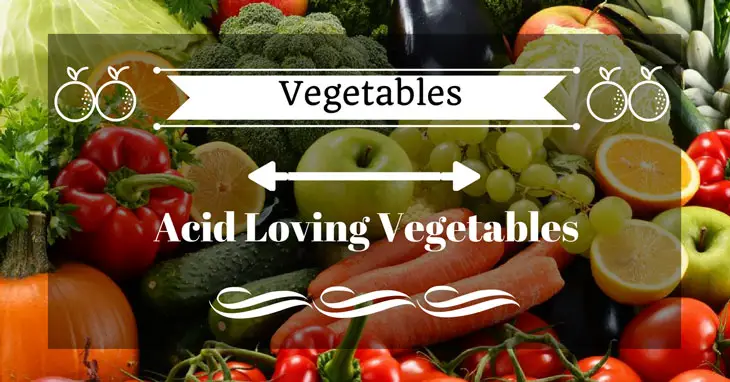Top 25 Acid Loving Vegetables You Need To Know
Although acidic soil is unfavorable to many plants, it still has some worth to note benefits. Some plants perform incredibly well in acidic soil. On the contrary, others need alkaline conditions to thrive. Here is a list of some of these acid-loving vegetables.
More...
What are Acid Loving Vegetables?
Acid loving vegetables are those crops that thrive in a soil with a pH level below 7 on the pH scale. Most of these vegetables usually prefer pH levels between 5 and 6.5.
According to the Ohio State University Extension, you can lower your soil pH by adding sulfur. This is mostly when you want to grow these vegetables and your soil is alkaline (a pH of 8 to 14).
Benefits of Acidic Soils
The acidity or pH level of a soil dictates what nutrients are available to plants. This also determines how efficiently the nutrients are absorbed.
Nutrients in soil become available to plants once they dissolve in soil moisture. These nutrients include elements such as phosphorus, nitrogen and potassium.
Test the soil pH of your garden’s planting beds to help you group plants by their pH needs when planting. This allows you to grow plants with similar pH needs and have a great harvest.
You can find the best soil ph tester in this post
Acid Loving Vegetables
Most vegetables thrive in a neutral soil pH level. But some tolerate slightly acidic soil. And there are those that do incredibly well in acidic soil. If you’ve got soil with a low pH, consider planting the following vegetables:
Radishes-These acid loving vegetables are fast-growing root crops that do well in soil with a pH as low as 4.5 to 5.5. To get a successful harvest, you should plant radishes in early spring or fall. You also need to make sure that they get ample sunlight, water, and well-draining soil. Try and harvest your radishes when they are still young. This is because fully matured radishes become woody and hot.

Radishes
Sweet Potatoes-These are flavorful tubers that are rich in vitamin A. They thrive in soil with a pH that range between 4.5 and 5.5. They usually demand a long growing season and are pretty hefty to grow in the north. If you reside in a mild climate, however, you can grow them successfully.
Parsley- These Mediterranean, biennial herbs grow best in soils with a pH between 5.5 and 6.5. They are slow starters. Thus, you should plant them a few weeks before last spring frost. Soak the seeds overnight for a speedier germination and sow in a moist, rich soil. Ensure that you keep the soil moist for success.
Peppers- Peppers mostly hot and bell varieties flourish in a soil pH ranging from 5.5 to 6.5. Plant them several weeks after last frost in a moist, rich, and well-draining soil. They are warm-season vegetables and thus, should be sowed in an area with ample sunlight.
Eggplants- They also known as Solanum melongena. These are flavorful veggies that grow best in warmer soils with a pH level between 6.3 and 6.8. Start your eggplants indoors to give them a head start and transplant once they reach 3 inches. Maintain consistent watering. They are usually ready for harvest after 3 to 4 months.

Eggplants
Rutabaga- These are biennial crops that prefer highly fertile, well-drained soil with a pH of 5.5 to 6.8. Sow your rutabaga seed in late spring to have them ready in the fall or late winter.
Parsnips- These delicious root crops thrive in full sun, loose and fertile soil with a pH range of 5.5 to 6.8. They require a long growing season and are mostly grown as an annual vegetable. Plant fresh seeds and keep the soil moist by frequent watering. Harvest your parsnips before the ground freezes
Potatoes- These cool-season vegetables do well across a wide range of pH. But, they prefer slightly acidic soil in the pH range of 4.8 to 5.5. They also require loose and well-drained soil, rich in organic matter for them to flourish. Plant your potatoes in early spring and harvest at the end of growing season.
Rhubarb- These are perennial vegetables that perform best in properly drained, fertile soil with a pH as low as 5.5 up to 6.8. Plant it in early spring while the soil is warm and moist. You can harvest your rhubarb after 4 to 6 weeks or in the early summer.

Rhubarb
Artichokes- These are perennial vegetables that require rich soil with a pH of 6.5 to 7.0 for them to thrive. Plant them in full sun and keep the soil moist throughout the growing season. Harvest your artichokes in late July until frost.
If you want to know how to grow Artichoke from seed, read here!
Or growing Artichokes in pots, click here!
Pumpkins- These are warm-season vegetables that perform best in full sun and in acidic soil of 5.5 to 6.5 pH levels. Plant your pumpkin seeds in late May or mid-July and harvest before the first frost kicks in.
Beans- These are warm-season vegetables, meaning you should plant them after the last frost. They perform best in a slightly acidic soil of 5.5 to 6.8 pH level. They are warm-weather crops. Thus, you should grow them in full sun in soil and well-drained, fertilized soil.
Broccoli- Broccolis are cool-weather vegetable plants that demand to be grown in full sun and in rich soil. They demand soil with plenty of organic matter. They thrive in a soil pH between 5.5 and 7.0. Plant your broccoli seeds in mid-spring for a fall harvest.

Broccoli
Cabbage- Similar to the broccoli vegetable, cabbage prefers a soil pH in the range of 5.5 to 7.0 for them to flourish. You can grow this cool-season vegetable both in spring and fall and have a success. They demand a long growing season and grow best in slightly cool temperatures.
Carrots- These are fast-growing root vegetables that thrive in light, well-drained soil with a pH of 5.5 to 7.0. Plant carrot seeds in full sunlight a few weeks before the last frost date. Grow your carrots in raised bed and choose short varieties if your soil is heavy or rocky.
Cucumbers- Cucumbers are vegetables that grow best in acidic soil of between 5.5 to 7.0 pH levels. Grow your cucumbers in full sun and in light, rich soil for the best results. According to the Virginia Cooperative Extension, cucumbers are very tender plants. Therefore, you should add mulch accordingly. Trellis your plants if you are working in a limited space.
Onions- These annual plants belong to the Alliaceae family. They grow best in slightly acidic soils of a pH level between 6 and 7. Head start the seeds indoors and plant them in spring for fastest growth. Grow them in full sun and water consistently to have them ready 3 months days planting.

Onions
Squash- These warm season vegetables prefer a soil pH between 5.5 and 7.0. Start the seeds indoors before the final frost date. Then, plant them in early summer and harvest before the last frost. They mature in approximately 70 to 120 days after planting.
Sweet corn- These are warm season plants that need fertile, moderately acidic soil to flourish. They require a soil pH in the range of 5.5 to 7.0. Plant them about one inch deep and 10 inches apart in spring. Provide full sunlight and maintain consistent watering. Add fertilizer throughout the season and harvest 70 to 80 days after planting.
Tomatoes- Tomatoes are subtropical plants that demand well-draining, fertile soil. They demand soil with a pH of 6 to 6.8 for optimal growth. Plant your seeds in spring and about half inches deep and one inch apart. Harvest them after about 16 to 20 weeks when their color is even. Store your unripe tomatoes in a warm, shaded area to ripen.
Turnips- These are cool-season vegetables that you can grow in both spring and fall. They thrive in light, nutrient-rich soil with a pH of about 5.5 to 7.0. Lightly harvest the greens over the growing season. Pull up the roots once they attain the size of a golf ball.

Turnips
Asparagus- These are hardy perennial vegetables that prefer slightly acidic soil of a pH in the range of 6.0 to 6.8. They also need moderately fertile, well-drained soil. Grow them in full sunlight and add mulch during the fall season. Harvest your asparagus once the stalks reach a height of 6 to 12 inches.
Celery- This is a heavy feeder annual vegetable that works best in soil with a pH range of 5.7 to 6.8. Start your celery seeds indoors 8 weeks before the last frost date. Transplant the seedlings half inches deep into the soil and 10 inches apart. Harvest your celery vegetables before the first hard frost date. They are ready for harvest once the stalks are about 8 inches in height.
Lettuce- These are vegetables that grow best in moist and slightly acidic soil with a pH between 6 and 7. Grow them in fall and spring when the soil is cool for the best results. You can harvest your lettuce 50 to 100 days after planting, depending on the variety.
Horseradish- These perennial plants grow best from root cuttings and in rich, moist soil with a pH of 5.5 to 6.8. Plant your horseradish root cuttings in early spring for a fall harvest. Your horseradish roots will be ready after 160 days from the day you planted.

Horseradish
Conclusion
With that said, we hope you can now choose the best vegetables to grow in your garden without worry. Test the pH level of your garden soil before you decide on what vegetables to grow.
In case you want control pH of soil, you can read the link:
https://www.tinyplantation.com/soil-fertilizers/ph-up-and-down-for-soil
Sources:
http://pubs.ext.vt.edu/426/426-331/426-331.html
https://www.hunker.com/13407010/list-of-acid-loving-vegetable-plants
http://homeguides.sfgate.com/vegetables-prefer-acidic-soil-51176.html
https://www.harvesttotable.com/vegetable-crop-soil-ph-tolerances/
Was this article helpful to you? Do you know of other vegetables that grow best in acidic soil? Let us know in the comment area.

